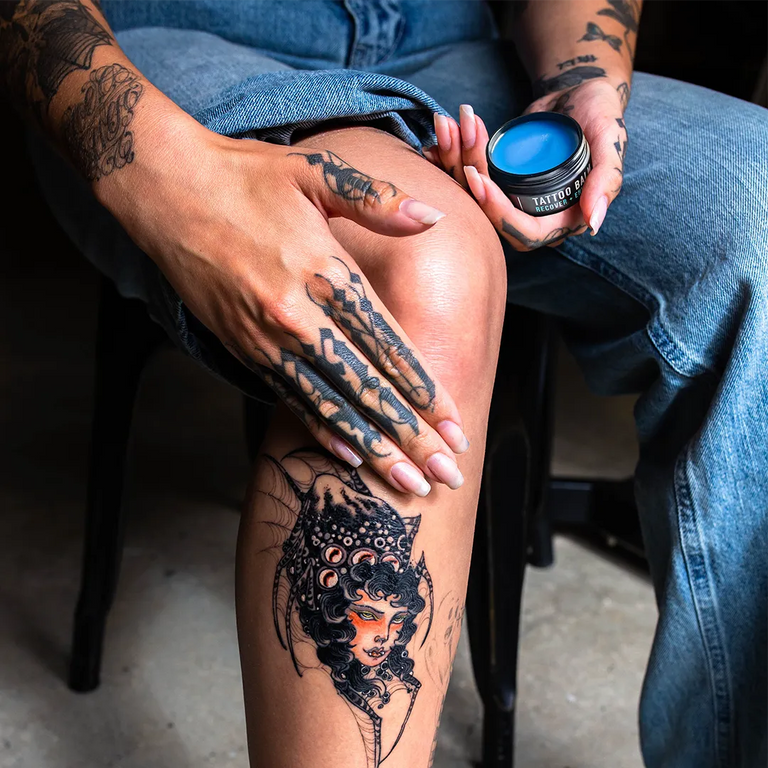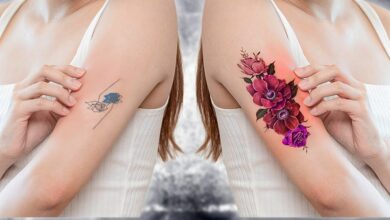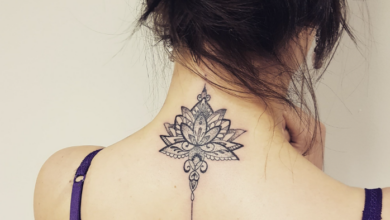
You recently got a tattoo, and now you’re wondering how to take care of it properly so that it heals beautifully and lasts a lifetime. Look no further than Stylish.ae’s Essential Guide to Tattoo Healing. This comprehensive article will walk you through all the necessary steps and precautions to ensure your tattoo heals flawlessly, from cleaning and moisturizing techniques to avoiding common mistakes. Don’t let the fear of potential complications dampen your excitement for your new ink. Follow this guide, and you’ll be well on your way to a stunning, well-healed tattoo.

Choosing the Right Tattoo Artist
When it comes to getting a tattoo, choosing the right artist is crucial. After all, they will be permanently marking your skin, so you want someone who is not only skilled but also matches your personal style and vision. Researching tattoo artists is the first step in finding the right one for you.
Researching tattoo artists
Start by researching tattoo artists in your area. Look for artists who specialize in the style you are interested in, whether it’s traditional, watercolor, black and gray, or something unique. Browse their websites, social media pages, and online portfolios to get a sense of their work. Pay attention to their attention to detail, precision, and overall artistic ability.
Reading reviews and testimonials
Take the time to read reviews and testimonials from previous clients. This will give you valuable insight into the artist’s professionalism, hygiene practices, and customer satisfaction. Look for artists who have consistently positive reviews and glowing testimonials. This will give you peace of mind knowing that you are working with a reputable and talented artist.
Examining portfolios
One of the most important aspects of choosing a tattoo artist is examining their portfolio. A portfolio is a collection of their previous work and will give you a clear idea of their style, skill level, and attention to detail. Look for clean lines, vibrant colors, and well-executed designs. Pay attention to the overall composition and how the tattoos age over time. A skilled artist will have a diverse portfolio, showcasing their versatility and ability to create unique and customized designs.
Having consultations
Before committing to a tattoo artist, it’s important to have a consultation. This gives you the opportunity to discuss your ideas, ask questions, and get a feel for the artist’s personality and professionalism. During the consultation, communicate your vision and expectations clearly. A good tattoo artist will listen attentively, offer expert advice, and work with you to bring your vision to life. If you don’t feel comfortable or confident after the consultation, don’t hesitate to continue your search until you find the perfect artist for you.
Preparing for the Healing Process
Getting a tattoo is not just about the design and the excitement of the experience. It’s also essential to be prepared for the healing process that follows. Proper aftercare is crucial to ensure your tattoo heals well and maintains its vibrancy for years to come.
Understanding the importance of aftercare
Aftercare is the key to a successful healing process. It involves taking care of your tattooed skin to facilitate proper healing, prevent infection, and ensure the longevity of the tattoo. It’s essential to understand the importance of aftercare and commit to following the instructions given by your tattoo artist.
Following the instructions given by the tattoo artist
Your tattoo artist will provide you with specific aftercare instructions tailored to your tattoo. These instructions may include how long to keep the initial bandage on, which products to use for cleaning and moisturizing, how often to clean and moisturize your tattoo, and any restrictions on activities or clothing that may affect the healing process. Following these instructions diligently is crucial to ensure a successful healing process.
Gathering necessary supplies
Before getting your tattoo, it’s crucial to gather the necessary supplies for aftercare. This may include fragrance-free soap, clean towels, a gentle moisturizer recommended by your tattoo artist, and any additional products they suggest. Having these supplies ready before your tattoo appointment will ensure a smooth transition into the healing process.
Preparing the tattooed area
In preparation for the healing process, it’s important to make sure the tattooed area is clean and ready for aftercare. This may involve shaving the area if necessary, ensuring the skin is free from any lotions or oils, and wearing loose-fitting clothing to avoid friction or irritation. By preparing the tattooed area properly, you can create an ideal environment for the healing process to take place.
Immediate Aftercare
The immediate aftercare of your tattoo sets the foundation for the healing process. It’s important to follow a few essential steps to promote proper healing and minimize the risk of infection.
Leaving the bandage on for the recommended time
After getting your tattoo, your tattoo artist will apply a bandage to protect the fresh tattoo. It’s important to leave this bandage on for the recommended time, usually a few hours, or as instructed by your tattoo artist. This bandage serves as a barrier against bacteria and protects the tattoo from external elements.
Cleaning the tattoo properly
Once you remove the initial bandage, it’s crucial to clean your tattoo properly. Use mild, fragrance-free soap and lukewarm water to gently cleanse the tattoo. Avoid harsh scrubbing or excessive rubbing, as this can damage the delicate healing skin. Thoroughly rinse off all soap residue to ensure a clean and infection-free tattoo.
Applying ointment or moisturizer
After cleaning, apply a thin layer of ointment or moisturizer recommended by your tattoo artist. This helps keep the tattoo moisturized, prevents excessive dryness, and promotes proper healing. Avoid using products that contain fragrances, dyes, or harsh chemicals, as these can irritate the healing skin.
Avoiding excessive exposure to sunlight
During the healing process, it’s important to protect your tattoo from excessive exposure to sunlight. The UV rays can fade the tattoo and prolong the healing process. If you need to be outside, make sure to keep your tattoo covered with clothing or use a broad-spectrum sunscreen with a high SPF to shield your tattoo from harmful rays.
Cleaning and Hygiene
Maintaining proper cleanliness and hygiene during the healing process is crucial to prevent infections and complications. Follow these guidelines to ensure your tattoo heals well and stays healthy.
Washing hands before touching the tattoo
Before touching your tattoo, always wash your hands thoroughly with soap and water. This helps eliminate any bacteria or dirt that could potentially contaminate the tattoo, leading to infections. Clean hands are essential when applying ointment, moisturizer, or performing any necessary cleaning routines.
Using mild, fragrance-free soap
When cleaning your tattoo, always use a mild, fragrance-free soap. Harsh soaps or cleansers can irritate the healing skin and cause adverse reactions. Gentle and hypoallergenic soaps are less likely to contain irritants and are safer for the sensitive tattooed area.
Patting the tattoo dry with a clean towel
After cleaning the tattoo, avoid rubbing or scrubbing the area with a towel. Instead, gently pat the tattoo dry with a clean, soft towel. Rubbing can cause unnecessary friction and potentially damage the healing skin. It’s vital to be gentle to promote proper healing.
Avoiding soaking the tattoo in water
During the healing process, it’s essential to avoid soaking your tattoo in water, such as baths, hot tubs, or swimming pools. Prolonged exposure to water can soften the scabs, making them more prone to lifting and potentially causing color loss. It’s best to keep the tattooed area dry and avoid any activities that involve prolonged water exposure.

Moisturizing and Protecting
Moisturizing and protecting your tattoo are essential steps in the aftercare process. These practices help keep the tattoo hydrated, promote proper healing, and maintain its vibrancy for years to come.
Using a recommended tattoo aftercare product
Your tattoo artist may recommend a specific tattoo aftercare product, such as a tattoo-specific moisturizer or ointment. These products are designed to nourish and protect the tattooed skin without causing any adverse reactions. Applying a recommended aftercare product ensures that your tattoo receives the necessary nutrients and stays moisturized throughout the healing process.
Applying a thin layer of moisturizer regularly
Moisturization is key during the healing process. Apply a thin layer of moisturizer to your tattoo regularly, as instructed by your tattoo artist. This helps relieve dryness, prevents itching, and promotes proper healing. However, avoid over-moisturizing, as it can suffocate the tattoo and delay the healing process.
Avoiding picking at scabs or peeling skin
As your tattoo heals, it may develop scabs or start peeling. It’s crucial to resist the temptation to pick at these scabs or peel the skin prematurely. Picking at scabs can disrupt the healing process, cause scarring, and result in color loss. Let the scabs and peeling skin naturally fall off on their own to ensure proper healing.
Protecting the tattoo from direct sunlight and abrasive clothing
During the healing process, it’s important to protect your tattoo from direct sunlight and abrasive clothing. Sun exposure can fade the tattoo and prolong the healing process. Opt for loose-fitting clothing made from soft fabrics to avoid friction and irritation. If you need to be out in the sun, apply a broad-spectrum sunscreen with a high SPF to provide extra protection.
Managing Discomfort and Itching
During the healing process, it’s common to experience discomfort and itching. While these sensations can be challenging to handle, it’s important to manage them properly to avoid complications.
Avoiding scratching the tattoo
Itchy tattoos can be incredibly tempting to scratch, but it’s crucial to resist the urge. Scratching can damage the delicate healing skin, introduce bacteria, and potentially lead to infections or scarring. Instead of scratching, gently tap or pat the itchy area, or use a clean fingertip to apply mild pressure to alleviate the itch.
Using a cold compress to relieve itching
If the itchiness becomes unbearable, you can use a cold compress to relieve the sensation temporarily. Wrap a clean, soft cloth or ice pack in a thin towel and apply it to the itchy area for a few minutes. The cold temperature helps numb the area and reduces the urge to scratch.
Taking over-the-counter pain relievers if necessary
If you’re experiencing discomfort or pain, you can take over-the-counter pain relievers, such as acetaminophen or ibuprofen, following the recommended dosage. These medications can help alleviate pain and reduce inflammation. However, always consult with your healthcare provider or pharmacist before taking any medication to ensure they are safe for you.
Seeking professional advice if severe pain or allergic reactions occur
While some discomfort and itching are normal during the healing process, severe pain or allergic reactions are not. If you experience intense or persistent pain, swelling, redness, or signs of an allergic reaction, seek professional advice immediately. Your tattoo artist or healthcare provider will be able to assess the situation, provide guidance, and recommend appropriate treatment if necessary.

Diet and Lifestyle Considerations
Your diet and lifestyle can play a significant role in the healing process of your tattoo. By following these considerations, you can optimize your body’s ability to heal and ensure a successful outcome.
Eating a balanced and nutritious diet
Proper nutrition is essential for overall health and healing. During the healing process, focus on eating a balanced and nutritious diet rich in fruits, vegetables, lean proteins, and whole grains. These foods provide the necessary vitamins, minerals, and antioxidants to support your body’s healing process and promote optimal tattoo healing.
Avoiding excessive alcohol consumption
Excessive alcohol consumption can dehydrate your body and weaken your immune system, prolonging the healing process of your tattoo. It’s essential to avoid excessive alcohol intake during the healing phase. Choose hydrating beverages like water and herbal teas to stay properly hydrated and support the healing process.
Getting enough sleep and rest
Adequate sleep and rest are essential for your body to heal effectively. Make sure to prioritize getting enough sleep and rest during the healing process. Sleep allows your body to regenerate and repair damaged cells, promoting optimal healing. Aim for seven to nine hours of quality sleep each night to support the healing of your tattoo.
Avoiding strenuous exercise and excessive sweating
While exercise is beneficial for overall health, it’s important to avoid strenuous activities and excessive sweating during the healing process of your tattoo. Sweating can irritate the healing skin and potentially introduce bacteria, leading to complications. Opt for light exercises or activities that do not cause excessive sweating until your tattoo is fully healed.
Avoiding Complications and Infections
Taking precautions to avoid complications and infections is vital during the healing process. By following these guidelines, you can ensure a smooth healing journey and preserve the quality of your tattoo.
Avoiding swimming pools, hot tubs, and saunas
During the healing process, it’s crucial to avoid swimming pools, hot tubs, and saunas. These environments are breeding grounds for bacteria and can significantly increase the risk of infection. Submerging your tattoo in water can soften scabs, prolong the healing process, and increase the likelihood of color loss. It’s best to stay out of these environments until your tattoo is fully healed.
Not exposing the tattoo to unsanitary environments
To minimize the risk of infection, it’s important to keep your tattoo away from unsanitary environments. Avoid exposing your tattooed skin to dirt, dust, pet hair, or any other contaminants. If you work in an environment that may compromise the cleanliness of your tattoo, take additional precautionary measures, such as covering it with a clean, breathable barrier.
Keeping pets away from the tattooed area
While pets are beloved members of the family, it’s crucial to keep them away from your tattooed skin during the healing process. Pet hair, saliva, or dander can introduce bacteria or irritants to your tattoo, increasing the risk of infection. Keep your pets at a safe and sanitary distance until your tattoo is fully healed.
Recognizing signs of infection and seeking medical attention
Despite taking all the necessary precautions, complications and infections can still occur. It’s important to recognize the signs of infection, such as increased pain, redness, swelling, pus, or a foul odor emanating from the tattooed area. If you suspect an infection, seek medical attention immediately. Prompt treatment can prevent further complications and ensure proper healing of your tattoo.

Tattoo Touch-ups and Follow-up Care
In some cases, touch-ups may be necessary to perfect your tattoo or to address any areas that may have faded during the healing process. Follow these guidelines for touch-ups and ensure proper follow-up care.
Understanding the need for touch-ups
Tattoos can sometimes require touch-ups to address any imperfections or areas that may not have retained the desired color intensity during the healing process. Understanding that touch-ups are a normal part of the tattooing process will help manage expectations and ensure your tattoo looks its best.
Scheduling a follow-up appointment with the tattoo artist
If your tattoo artist deems it necessary to perform a touch-up, schedule a follow-up appointment with them. They will assess the tattoo, identify any areas that require attention, and work with you to schedule a convenient time to make the necessary adjustments. It’s important to follow their advice and recommendations for the best possible outcome.
Following any specific instructions given for touch-ups
Just like during the initial healing process, your tattoo artist may provide specific instructions for the touch-up session. These instructions may include avoiding certain activities, adhering to a specific aftercare routine, or using particular products. Following these instructions diligently will ensure that the touch-up session is successful and contributes to the long-term quality of your tattoo.
Continuing good aftercare practices during the healing process
After a touch-up session, it’s important to continue practicing good aftercare routines. Follow the same cleaning, moisturizing, and protection guidelines as you did during the initial healing process. Consistency in aftercare practices is key to ensuring a successful touch-up and maintaining the overall quality of your tattoo.
Long-Term Care and Maintenance
Even after your tattoo has fully healed, it’s important to continue providing proper care and maintenance to preserve its vibrancy and longevity. Follow these guidelines for long-term care and maintenance.
Moisturizing the tattoo regularly
Moisturization remains a crucial aspect of long-term tattoo care. Even after your tattoo has healed, continue moisturizing it regularly to keep the skin hydrated and maintain the tattoo’s vibrancy. Use a gentle, fragrance-free moisturizer daily to prevent dryness and promote the longevity of your tattoo.
Using sunscreen to protect the tattoo from fading
Sunscreen should become a regular part of your routine if you want to preserve the vibrancy of your tattoo. Exposure to sunlight can cause the tattoo to fade over time. Apply a broad-spectrum sunscreen with a high SPF to your tattoo every day, especially when exposed to the sun for an extended period. This will help protect the tattoo from the damaging effects of UV rays and ensure its colors stay vibrant.
Avoiding exposing the tattoo to harsh chemicals
In your daily life, be mindful of exposing your tattoo to harsh chemicals. Chemicals found in cleaning products, beauty products, or even some clothing can irritate and fade your tattoo. Avoid direct contact with these substances by wearing protective clothing or gloves when handling them. By minimizing exposure to harsh chemicals, you can help prolong the life and quality of your tattoo.
Seeking professional advice for any concerns or issues
If you ever have any concerns or issues with your tattoo, don’t hesitate to seek professional advice. Your tattoo artist or a dermatologist will be able to assess the situation, provide guidance, and recommend appropriate treatment if necessary. It’s important to address any issues promptly to prevent further complications and ensure the long-term health and appearance of your tattoo.
In conclusion, choosing the right tattoo artist, preparing for the healing process, and following proper aftercare are crucial steps to ensure the successful healing of your tattoo. By conducting thorough research, communicating with your tattoo artist, and following their aftercare instructions, you can enjoy a well-healed and vibrant tattoo for years to come. Remember to maintain good hygiene and cleanliness, moisturize and protect your tattoo, manage discomfort and itching, consider your diet and lifestyle, avoid complications and infections, schedule touch-ups if necessary, and provide long-term care and maintenance. With proper care and attention, your tattoo will continue to be a beautiful expression of your personal style and identity.

Stylish.ae’s Introduction To The World Of Tattoos(Opens in a new browser tab)Tattooing 101: Choosing The Right Tattoo’s Ink For Your Skin(Opens in a new browser tab)
Stylish.ae’s Introduction To The World Of Tattoos(Opens in a new browser tab)
Inked And Elegant: How Tattoos Complement Personal Style On Stylish.ae(Opens in a new browser tab)




